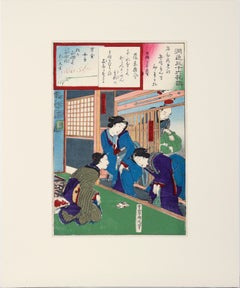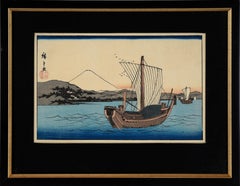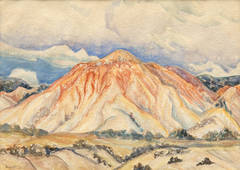Ina Annette Art
to
1
Overall Width
to
Overall Height
to
1
1
1
1
1
1
1
1
1
10,138
2,779
1,375
1,369
1
Artist: Ina Annette
Original Woodcut - Sheep Ranch
By Ina Annette
Located in Phoenix, AZ
Excellent Woodcut print by Oklahoma/New Mexico artist Ina Annette (1901-1990).
The image measures 10 ½ x 13 ½ inches. The work rests in a 17 1/4 x 20 1/4 inch museum mat.
The print i...
Category
Mid-20th Century Ina Annette Art
Materials
Paper, Woodcut
Related Items
"Enshoku Sanju-roku Kasen" (Thirty-six Enchanting Flowers) Woodblock on paper
By Toyohara Kunichika
Located in Soquel, CA
"Enshoku Sanju-roku Kasen" (Thirty-six Enchanting Flowers) Woodblock on paper
Elegant woodblock print by Toyohara Kunuchika (Japanese, 1835-1900). Three women are in talking with each other inside, while a man waits outside holding a bag of some kind. The colors in this piece are rich and saturated, primarily blues, greens, and purple.
Mat size: 16"H x 20"W
Paper size: 14.75"H x 9.88"W
Born in 1835, Toyohara Kunichika grew up in the Kyobashi district of Edo in the midst of merchants and artisans. In 1848, at age 13, he was accepted as an apprentice into the studio of Utagawa Kunisada I...
Category
1880s Edo Ina Annette Art
Materials
Ink, Rice Paper, Woodcut
$380 Sale Price
20% Off
H 20 in W 16 in D 0.25 in
Kiyomi Barrier & Seiken Temple Near Okitsu- Japanese Woodcut Print on Rice Paper
By Utagawa Hiroshige
Located in Soquel, CA
Kiyomi Barrier & Seiken Temple Near Okitsu - Japanese Woodcut Print on Rice Paper
Woodblock print of boats in a harbor by Utagawa Hiroshige (Japanese, 1797-1858). Originally publish...
Category
1850s Impressionist Ina Annette Art
Materials
Rice Paper, Woodcut
$1,240 Sale Price
20% Off
H 15.5 in W 19.25 in D 1.25 in
Two Actors - Japanese Woodblock by Chikanobu Yoshu
By Toyohara Chikanobu
Located in Soquel, CA
Two Actors - Japanese Woodblock by Toyohara Chikanobu (豊原周延, 1838–1912), better known to his contemporaries as Yōshū Chikanobu (楊洲周延).
Colorful and expressive court scene. Two actors...
Category
1890s Edo Ina Annette Art
Materials
Ink, Rice Paper, Woodcut
$700 Sale Price
20% Off
H 18.5 in W 13.5 in D 1 in
'Cherry Blossoms at Dusk', Japanese color woodblock, Musashino College of Art
Located in Santa Cruz, CA
Signed lower right, 'Morihiro Sato' (Japanese, born 1943), with artist chop mark, and dated 1985; titled, lower left, in English and Kanji 'Cherry Trees (Dusk)' with number and limitation, '3/55'.
Paper dimensions: 24.25 x 35.5 inches
A fresh and unfaded woodblock print showing a view of cherry tree boughs heavy with glowing blossoms before a vista of rolling hills with stylized Japanese pine beneath a luminous, golden sunset.
Morihiro Sato graduated from Musashino College of Fine Art before studying under the printmaker Joichi Hoshi (1913-1979). Sato’s work focuses on the beauty of nature, particularly that of trees. Through the medium of woodblock with inclusion of metallic pigments, his delicately atmospheric prints evoke a sense of gentle sense of wonder.
*With thanks to Ronin Gallery
Category
1980s Modern Ina Annette Art
Materials
Gold Leaf
$3,600
H 22 in W 33.75 in
Kiyomizu Temple, Scenes of Famous Places along Tôkaidô Road - Woodblock on Paper
By Utagawa Hiroshige II
Located in Soquel, CA
Kiyomizu Temple, Scenes of Famous Places along Tôkaidô Road - Woodblock on Paper
Full Title:
Kyoto: Kiyomizu Temple (Kyô Kiyomizudera), from the series Scenes of Famous Places along...
Category
1860s Edo Ina Annette Art
Materials
Ink, Rice Paper, Woodcut
$960 Sale Price
20% Off
H 20 in W 16 in D 0.25 in
Page from "Spring View in Takanawa" Mid 18th Century Ukiyo-e Print
By Utagawa Kunisada (Toyokuni III)
Located in Soquel, CA
Page from "Spring View in Takanawa" Mid 18th Century Ukiyo-e Print
Left page from the triptych print "Spring View in Takanawa" by Utagawa Kunisada (Toyokuni III) (Japanese b. 1786 d...
Category
1840s Edo Ina Annette Art
Materials
Printer's Ink, Mulberry Paper, Woodcut
$950
H 19 in W 13 in D 0.25 in
Stage 48 of the 53 Stages of the Tokaido - Japanese Woodblock on Rice Paper
By Utagawa Hiroshige
Located in Soquel, CA
Stage 48 of the 53 Stages of the Tokaido - Japanese Woodblock on Rice Paper
Woodblock print of clothing vendors by Utagawa Hiroshige (Japanese, 1797-1858). Originally printed in 183...
Category
1830s Impressionist Ina Annette Art
Materials
Rice Paper, Woodcut
$1,240 Sale Price
20% Off
H 15.5 in W 19.25 in D 1.25 in
Actor as Samurai - 18th Century Japanese Woodblock Print
By Katsukawa Shunshō
Located in Soquel, CA
Actor as Samurai - 18th Century Japanese Woodblock Print
Woodblock print depicting an actor, possibly Nakamura Denkuro II, as a samurai. The actor stands with his sword unsheathed a...
Category
Late 18th Century Edo Ina Annette Art
Materials
Woodcut, Rice Paper
$750
H 19 in W 12.5 in D 0.63 in
Mitate of a Daimyo's Procession Crossing Ryogoku Bridge - Woodblock Print
By Keisai Eisen
Located in Soquel, CA
Mitate of a Daimyo's Procession Crossing Ryogoku Bridge - Woodblock Print
Woodblock print of a procession by Keisai Eisen (Japanese, 1790–1848). Terrific triptych of a procession of...
Category
Early 19th Century Edo Ina Annette Art
Materials
Ink, Rice Paper, Woodcut
$1,320 Sale Price
20% Off
H 24 in W 36 in D 0.25 in
Wolfdietrich - Original leaflet from Johann Prüss' Das Heldenbuch
Located in Soquel, CA
Original leaflet from Johann Prüss' 1479 printing of "Das Heldenbuch."
The Heldenbücher is the title given to a group of late medieval/early renaissance Germanic manuscripts primari...
Category
15th Century and Earlier Medieval Ina Annette Art
Materials
Paint, Laid Paper, Woodcut
$1,500
H 13.82 in W 10.57 in D 0.63 in
Amsterdam - Woodcut Print by Frans Masereel - 1933
By Frans Masereel
Located in Roma, IT
Amsterdam is an artwork realized by Frans Masereel, 1933.
Woodcut print representing Amsterdam.
75 x 55 with frame; 17h x 12 cm each work.
Good conditions.
Category
Early 20th Century Modern Ina Annette Art
Materials
Paper, Woodcut
$300
H 29.53 in W 21.66 in D 0.4 in
A Handsome Woodcut on Paper of the Univ. of Chicago Chapel by Siegfried Weng
Located in Chicago, IL
A handsome woodcut on paper of the University of Chicago Chapel by artist Siegfried Weng. A perfect gift for your U of C grad! Arwork size:
9 3/4" x 7 1/2". Archivally matted to...
Category
1920s American Modern Ina Annette Art
Materials
Paper, Woodcut
Previously Available Items
Rock Candy Mountain, Utah
By Ina Annette
Located in Denver, CO
Housed in a custom frame with all archival materials; outer dimensions measure 18.75 x 22.25 inches. Image measures 9 x 13 inches.
Expedited and International Shipping is availabl...
Category
1930s American Modern Ina Annette Art
Materials
Watercolor
Ina Annette art for sale on 1stDibs.
Find a wide variety of authentic Ina Annette art available for sale on 1stDibs. You can also browse by medium to find art by Ina Annette in ink, paper, woodcut print and more. Much of the original work by this artist or collective was created during the 1950s and is mostly associated with the Impressionist style. Not every interior allows for large Ina Annette art, so small editions measuring 23 inches across are available. Customers who are interested in this artist might also find the work of Levon West, Harvey Kidder, and Ronald Julius Christensen. Ina Annette art prices can differ depending upon medium, time period and other attributes. On 1stDibs, the price for these items starts at $680 and tops out at $680, while the average work can sell for $680.


